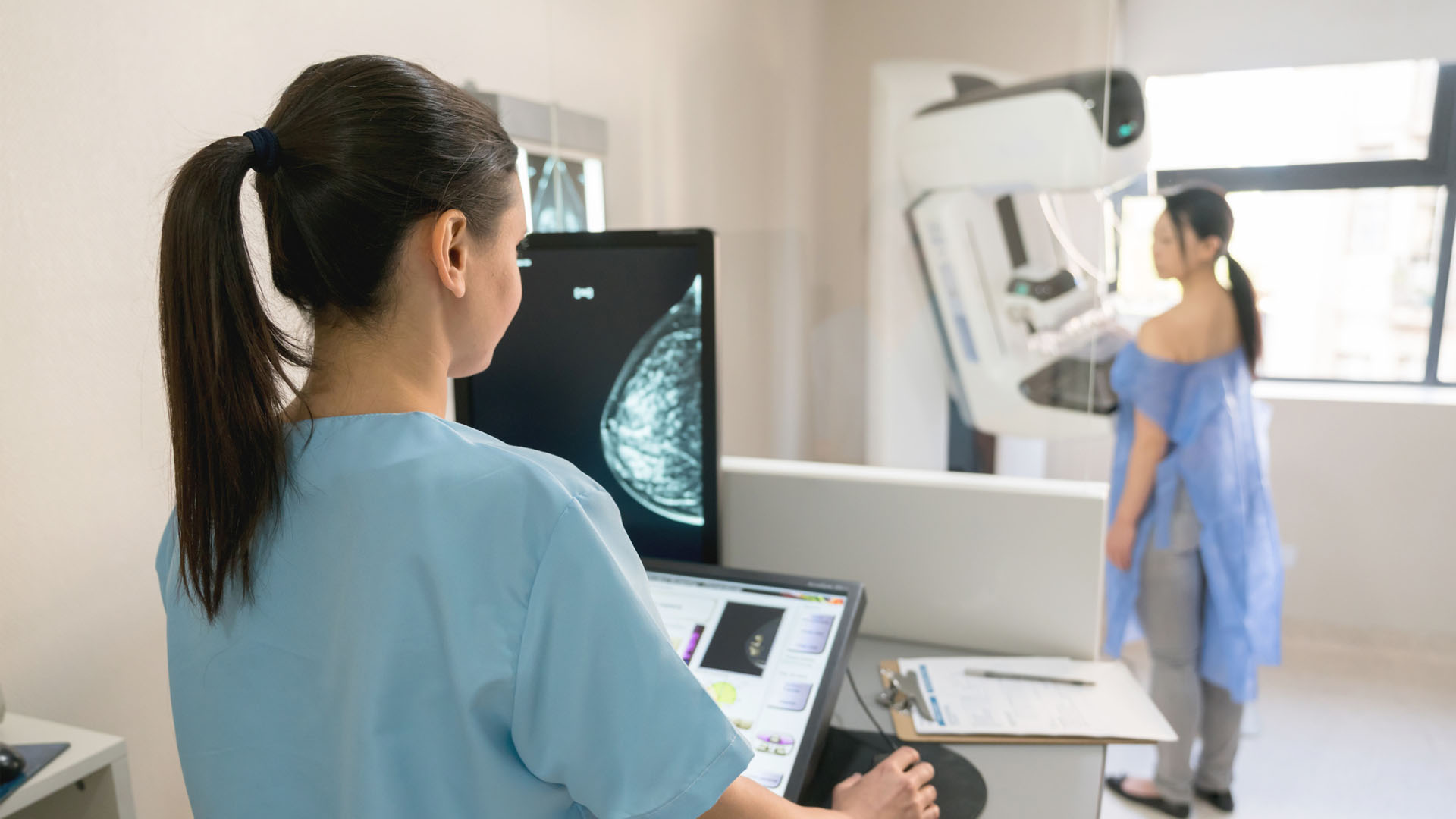Breast cancer: Symptoms, treatment and prevention
Breast cancer is the second most common cancer among women in the United States.

Breast cancer is an uncontrolled growth of cells that starts in the breast tissue. About one in eight women in the United States will develop the condition in their lifetime, according to the National Institutes of Health (NIH).
It is the second most common cancer in women, after skin cancer, and in 2022 more than 287,000 U.S. women were diagnosed with the condition, according to the National Cancer Institute.
Breast cancer is most commonly diagnosed in women aged 65-74. The disease can also occur in men, but it is much less common: Male breast cancer accounts for less than 1% of all breast cancer cases, according to the NCI.
Survival rates for breast cancer have increased in recent years. Between 2012 and 2018, about 90.6% of breast cancer patients lived for at least five years after their diagnosis, according to the NCI.
What causes breast cancer?
The exact cause of breast cancer — that is, what causes breast cells to start to grow out of control — is not known. The combination of a person's genetics and their environment likely plays a role in the development of the disease, according to the Mayo Clinic.
In about 5 to 10 percent of breast cancer cases, genetic mutations are linked to the disease. For example, women with mutations in the BRCA genes are at increased risk for breast cancer. Some studies show that women with mutations in the BRCA1 gene have a 50% to 70% chance of getting breast cancer by age 70, and women with mutations in the BRCA2 gene have a 40% to 60% chance, according to the Susan G. Komen Foundation, a nonprofit organization that funds breast cancer research and advocates for patients.

Other risk factors include a family history of breast cancer, starting menstrual periods before age 12 or going through menopause after age 55, not having children and using hormone therapy after menopause, according to the American Cancer Society. However, most women who get breast cancer don't have any risk factors for the disease, other than their gender and age, the ACS says.
Extremely dense breasts can also be a risk factor. Breast tissue is composed of milk glands, milk ducts, supportive tissue (dense breast tissue) and fatty tissue (non-dense breast tissue). Women with denser breasts have more dense tissue than fatty tissue, according to the Mayo Clinic. Levels of density can be recorded on a mammogram and are split into the following levels:
A: Almost entirely fatty (about 1 in 10 women has this result)
B: Scattered areas of fibroglandular density (Accounts for about 4 in 10 women)
C: Heterogeneously dense (some areas of non-dense tissue, but the majority is dense. About 4 in 10 women have this result)
D: Extremely dense (Nearly all the breast tissue is dense. About 1 in 10 women has this result)
According to a 2023 survey published in Jama Network Open, women with extremely dense breasts face a risk of breast cancer four times higher than women with low density breasts.
What are the symptoms of breast cancer?
Not everyone with breast cancer will have symptoms before they are diagnosed. But, according to the Centers for Disease Control and Prevention (CDC), possible symptoms of the disease include:
- A lump in the breast or armpit
- A thickening or swelling of part of the breast
- Dimpling of the breast or skin irritation
- Red or flaky skin in the nipple area
- An inverted nipple or pain in the nipple area
- Nipple discharge other than breast milk
- Any change in the size or shape of the breast
It's important to note that even these symptoms don’t necessarily mean a malignancy is present and often signal a benign condition, such as a cyst or infection.
Breast cancer screening
Breast cancer screening tests are done on symptom-free women, with the goal of catching the disease early. One of the main screening tests is a mammogram, or an X-ray of the breast. The United States Preventive Services Task Force recommends mammograms every two years for women ages 50 to 74.
However, exactly when women should start to get mammograms, and how frequently they should get them, has been debated. For example, the American Cancer Society recommends that women get their first mammogram starting at age 40, and get them every year after.
Some studies suggest a benefit to regular mammogram screening. A 2013 study of breast cancer patients in Boston, published in the journal Cancer, found that, among women who died of the disease, most had not undergone regular breast cancer screening. However, some researchers criticized the study because it did not look at screening rates among women who survived breast cancer.
A major concern with breast cancer screening is that it increases the risk of "overdiagnosis," that is, diagnosis of cancers that would not cause noticeable disease during women's lifetimes. A 2012 study published in the journal Annals of Internal Medicine found that up to 25% of women diagnosed with breast cancer through a mammogram were actually overdiagnosed.

Another 2012 study, published in the New England Journal of Medicine, found that, while mammograms have increased detection of early-stage breast cancers, they have done little to reduce the risk of death from advanced stage breast cancer.
There is also concern that frequent mammograms increase the chance that a woman will receive a false positive result: A 2011 study in the journal Annals of Internal Medicine found that 61% of women who get yearly mammograms will have at least one false positive result over a decade.
The CDC recommends that women ages 40 to 49 speak with their doctor about when to start mammograms, and how often to get them.
Other screening tests for breast cancer include a clinical breast exam, in which a doctor feels for lumps or changes in the breast, or a self-exam, when a woman checks her own breasts for lumps or changes in size or shape. However, neither a clinical breast exam nor a self-exam have been found to decrease the risk of dying from breast cancer, according to the CDC. So if women have these exams, they should also undergo mammograms as well, if they are in the age group for which mammograms are recommended.
How is breast cancer diagnosed?
If a screening method reveals possible breast cancer, follow-up tests are done to confirm the diagnosis. These include:
- Imaging tests such as mammograms, MRI scans or breast ultrasound. Each of these methods produces internal pictures of the breast that help doctors see a potential mass.
- Biopsies, which take cells from suspicious lumps to study in a pathology lab to determine if they are malignant. Cells are extracted through special needles or during surgery.
If cancer is confirmed, doctors will perform additional tests to determine whether the cancer has spread within the breast, to the lymph nodes or to other parts of the body.
The earliest form of breast cancer is called ductal carcinoma in situ, and means that the cancer cells are confined to the milk ducts in the breast. This type of breast cancer is non-invasive (meaning it has not spread to other parts of the breast), and is the most curable form of the disease.
If the breast cancer has spread beyond the ducts and invaded other breast tissue, it is called infiltrating ductal carcinoma. This is the most common form of the disease, accounting for nearly 80% of breast cancers, according to Johns Hopkins School of Medicine. This form of the disease could eventually spread to the lymph nodes or other parts of the body.
After diagnosis doctors also learn if the tumor is caused by a genetic mutation passed through families, or whether there are hormone receptors on the breast cancer cells, which indicate that the cancer may be responsive to hormonal treatment.
How is breast cancer treated?
The treatment for breast cancer depends on the type of cancer and whether it has spread within the breast or to other parts of the body. Many people with the disease get more than one treatment, the CDC says. Treatments generally either target the cancer at its location, or target cancer cells throughout the body.
Local treatments include surgery and radiation, which attempt to remove or destroy the cancer in the breast without affecting the rest of the body. Surgery can include a lumpectomy — a breast-conserving surgery that that removes the tumor and part of the surrounding tissue — or the more aggressive mastectomy, which removes the entire breast and is usually done in more advanced cases, according to the National Breast Cancer Foundation.

Systemic treatments (which affect the entire body) are given by mouth or through the bloodstream and target cancer cells throughout the body. These include chemotherapy, which uses toxic drugs such as cyclophoshamide (sometimes referred to by its brand name, Cytoxan) or methotrexate. Cancer fueled by the hormones estrogen or progesterone can be treated with hormone suppressors such as tamoxifen or raloxifene (Evista).
More recent systemic treatments include biological therapy, which use the immune system to fight the cancer and targets breast cancer cells containing high levels of a certain protein. Commonly used biologics are bevacizumab (Avastin) or trastuzumab (Herceptin).
A patient will likely see several doctors for her treatment, including surgeons, medical oncologists and radiation oncologists, according to the CDC.
This article is for informational purposes only and is not meant to offer medical advice.
Additional resources
Sign up for the Live Science daily newsletter now
Get the world’s most fascinating discoveries delivered straight to your inbox.

Rachael is a Live Science contributor, and was a former channel editor and senior writer for Live Science between 2010 and 2022. She has a master's degree in journalism from New York University's Science, Health and Environmental Reporting Program. She also holds a B.S. in molecular biology and an M.S. in biology from the University of California, San Diego. Her work has appeared in Scienceline, The Washington Post and Scientific American.










